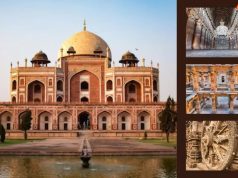These bridges are more than 100 years old
A living example of this is the Living Root Bridge of Meghalaya. These are more than 100 years old. For their beauty and uniqueness, these bridges were included in the tentative list of World Heritage Sites in 2022. UNESCO has recognized these bridges by the name “Jingkieng Jri”. It means – “Bridge made of living roots”.
These bridges are still standing strong today

What is a Living Root Bridge?
Living root bridge means a bridge that is made from the roots of a tree. These bridges are made by spreading the thick roots of the rubber tree (called Ficus elastica in scientific language) from one end to the other. These roots are slowly bent in a particular direction for many years, so that it can take the shape of a bridge. It takes 15 to 20 years to build it, but once built, these bridges can last up to 500 years.
Where are these bridges?
It is said that the longest living root bridge in Meghalaya is 175 feet long. There are about 100 or more living root bridges in different villages here. Living root bridges are famous in areas like Cherrapunji, Mawlynnong, Nongriat and Jaintia Hills of Meghalaya.
Two-storey bridge in Nongriat village
The most famous among these is the “Double Decker Root Bridge” which looks like a two-storey bridge. This bridge is present in Nongriat village and looks very beautiful. Crowds of tourists can be seen here. This place is no less than a paradise for photography enthusiasts.
 Image Credit- Meghalaya Tourism
Image Credit- Meghalaya Tourism
Why are these bridges special?
- Completely Natural: No cement, iron or machines are used in these.
- Durable and Strong: These bridges get stronger over time.
- Environment friendly: It does not cause any kind of pollution.
- Part of the local culture: These bridges reflect the local people’s tradition and connection with nature.
- Tourist attraction: Every year, crowds of tourists from across the country and abroad come here.
Local people and their art
These bridges not only enhance the beauty of those areas, but also help in the development and prosperity of those places. The art of making these bridges is passed on from the elders of the Khasi and Jaintia tribes to the next generation. This is not just a bridge, but a tradition of the hills. It is the responsibility of the local people to keep it alive. If you ever go to Meghalaya, then definitely visit these living bridges. This experience can become the most memorable part of your life.









